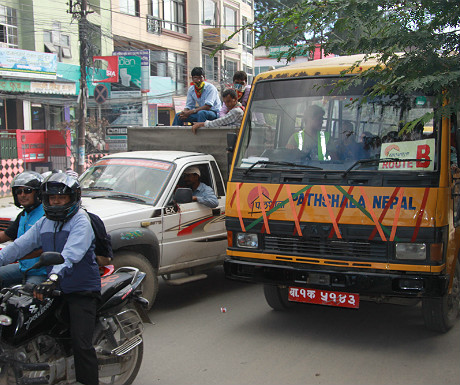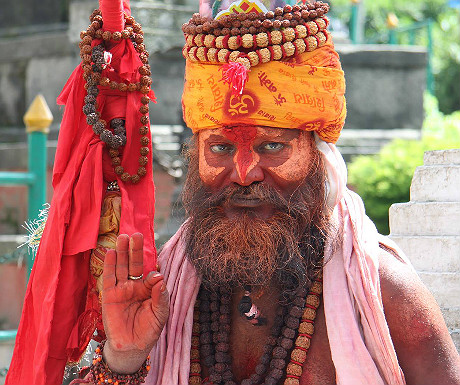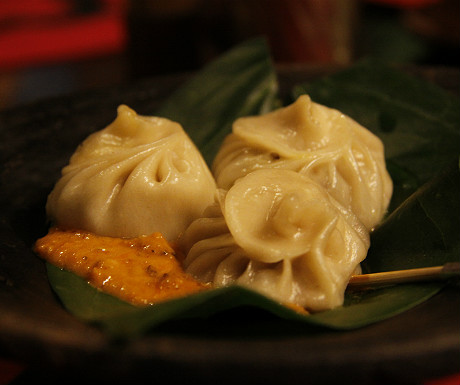Accommodation · Adventure Travel · Asia · Going Out · Hotels · India · Nepal · Regions · Restaurants · Road Travel · Speciality Travel
Day 1 of leg 8 of the Silk Road Trail 2013 – Kathmandu #SilkTrail2013
Our guide for the duration of our time in Nepal is Rabhindra, but he tells us we can call him Robin for short. He informs us about his country and its 125 ethnic groups as our bus trundles through Kathmandu, a city which has seen a 60% rise in its population in just the last 10 years.
The bus driver is called Ram which is rather fitting as he tries to charge his way through the heavy traffic. There are too many vehicles for the roads and this has prompted the government to adopt an extensive road-widening programme. Pavements are being taken back – even buildings in some cases – to accommodate Kathmandu’s increasingly chaotic traffic. Photographs convey the bedlam and dust to some extent but don’t disclose the noise of the traffic – the truck engines, the motorbikes and the ever-constant hooting of horns.
 Our first stop is at Kathmandu Palace Square. It’s a hive of activity around this area and we find ourselves quickly surrounded by hawkers. We find some solitude from this with a visit to Kumari, a living goddess, who makes a brief appearance at 11am each day at which point photographs are strictly not allowed. She appears on a balcony, is suprisingly young and disappears again within seconds.
After visiting the royal baths dating back to the 7th and 8th centuries, and being hassled once more to buy a singing bowl or some other souvenir, we head for Swayambunath (also known as the monkey temple). Prayer flags flutter in the breeze and a Hindu holy man allows us to take his picture.
Our first stop is at Kathmandu Palace Square. It’s a hive of activity around this area and we find ourselves quickly surrounded by hawkers. We find some solitude from this with a visit to Kumari, a living goddess, who makes a brief appearance at 11am each day at which point photographs are strictly not allowed. She appears on a balcony, is suprisingly young and disappears again within seconds.
After visiting the royal baths dating back to the 7th and 8th centuries, and being hassled once more to buy a singing bowl or some other souvenir, we head for Swayambunath (also known as the monkey temple). Prayer flags flutter in the breeze and a Hindu holy man allows us to take his picture.
 Soon after, I realise I get a little too close to a monkey as it makes a sudden gesture to cause me to back off. Thankfully I’d already got the shot I was hoping for, so didn’t push my luck any further.
Soon after, I realise I get a little too close to a monkey as it makes a sudden gesture to cause me to back off. Thankfully I’d already got the shot I was hoping for, so didn’t push my luck any further.
 At the top of the monkey temple, we are treated to a great panoramic view of the city before returning to our bus and moving on to our final stop of the day: Bhaktapur. Here we see more temples, a large Buddha and again hawkers follow us everywhere. When we say we’re not interested, they assume it’s the price that’s a problem, not that you just don’t want what they’re selling. I show a brief interest in one item which ensures I have a constant shadow for the rest our walk. I succumb to a purchase in the end but at less than a third of the price of what he was originally asking.
Back at the hotel, we enjoy a traditional Nepalese dinner before retiring to bed. For this, we have to remove our footwear and wash our hands before entering the restaurant, and find ourselves sitting cross-legged on low-lying stools and at a low table. There’s cutlery available but the traditional way is to eat with your right your hand. (AYour left hand is considered “not pure” as Robin politely puts it.)
As our starter arrives, it’s explained to us that we need to offer a small amount to the gods by placing a little on a leaf-shaped plate. The dinner is pretty good – for me the main highlight is the dumplings, described on the menu as “Momo – Nepali minced meat dumplings served with chutney”.
At the top of the monkey temple, we are treated to a great panoramic view of the city before returning to our bus and moving on to our final stop of the day: Bhaktapur. Here we see more temples, a large Buddha and again hawkers follow us everywhere. When we say we’re not interested, they assume it’s the price that’s a problem, not that you just don’t want what they’re selling. I show a brief interest in one item which ensures I have a constant shadow for the rest our walk. I succumb to a purchase in the end but at less than a third of the price of what he was originally asking.
Back at the hotel, we enjoy a traditional Nepalese dinner before retiring to bed. For this, we have to remove our footwear and wash our hands before entering the restaurant, and find ourselves sitting cross-legged on low-lying stools and at a low table. There’s cutlery available but the traditional way is to eat with your right your hand. (AYour left hand is considered “not pure” as Robin politely puts it.)
As our starter arrives, it’s explained to us that we need to offer a small amount to the gods by placing a little on a leaf-shaped plate. The dinner is pretty good – for me the main highlight is the dumplings, described on the menu as “Momo – Nepali minced meat dumplings served with chutney”.
 Tomorrow we start to make our way across Nepal in the Range Rover Hybrids. The three of them have made it this far from the UK, but can they make it all the way to the final destination of Mumbai? Come back to the blog tomorrow to follow our progress…
The Silk Road Trail 2013 is a 16,000 kilometre expedition across some of the world’s most challenging roads, passes and trails, and the final development drive for the new Range Rover Hybrid from Land Rover.
Tomorrow we start to make our way across Nepal in the Range Rover Hybrids. The three of them have made it this far from the UK, but can they make it all the way to the final destination of Mumbai? Come back to the blog tomorrow to follow our progress…
The Silk Road Trail 2013 is a 16,000 kilometre expedition across some of the world’s most challenging roads, passes and trails, and the final development drive for the new Range Rover Hybrid from Land Rover.
 Our first stop is at Kathmandu Palace Square. It’s a hive of activity around this area and we find ourselves quickly surrounded by hawkers. We find some solitude from this with a visit to Kumari, a living goddess, who makes a brief appearance at 11am each day at which point photographs are strictly not allowed. She appears on a balcony, is suprisingly young and disappears again within seconds.
After visiting the royal baths dating back to the 7th and 8th centuries, and being hassled once more to buy a singing bowl or some other souvenir, we head for Swayambunath (also known as the monkey temple). Prayer flags flutter in the breeze and a Hindu holy man allows us to take his picture.
Our first stop is at Kathmandu Palace Square. It’s a hive of activity around this area and we find ourselves quickly surrounded by hawkers. We find some solitude from this with a visit to Kumari, a living goddess, who makes a brief appearance at 11am each day at which point photographs are strictly not allowed. She appears on a balcony, is suprisingly young and disappears again within seconds.
After visiting the royal baths dating back to the 7th and 8th centuries, and being hassled once more to buy a singing bowl or some other souvenir, we head for Swayambunath (also known as the monkey temple). Prayer flags flutter in the breeze and a Hindu holy man allows us to take his picture.
 Soon after, I realise I get a little too close to a monkey as it makes a sudden gesture to cause me to back off. Thankfully I’d already got the shot I was hoping for, so didn’t push my luck any further.
Soon after, I realise I get a little too close to a monkey as it makes a sudden gesture to cause me to back off. Thankfully I’d already got the shot I was hoping for, so didn’t push my luck any further.
 At the top of the monkey temple, we are treated to a great panoramic view of the city before returning to our bus and moving on to our final stop of the day: Bhaktapur. Here we see more temples, a large Buddha and again hawkers follow us everywhere. When we say we’re not interested, they assume it’s the price that’s a problem, not that you just don’t want what they’re selling. I show a brief interest in one item which ensures I have a constant shadow for the rest our walk. I succumb to a purchase in the end but at less than a third of the price of what he was originally asking.
Back at the hotel, we enjoy a traditional Nepalese dinner before retiring to bed. For this, we have to remove our footwear and wash our hands before entering the restaurant, and find ourselves sitting cross-legged on low-lying stools and at a low table. There’s cutlery available but the traditional way is to eat with your right your hand. (AYour left hand is considered “not pure” as Robin politely puts it.)
As our starter arrives, it’s explained to us that we need to offer a small amount to the gods by placing a little on a leaf-shaped plate. The dinner is pretty good – for me the main highlight is the dumplings, described on the menu as “Momo – Nepali minced meat dumplings served with chutney”.
At the top of the monkey temple, we are treated to a great panoramic view of the city before returning to our bus and moving on to our final stop of the day: Bhaktapur. Here we see more temples, a large Buddha and again hawkers follow us everywhere. When we say we’re not interested, they assume it’s the price that’s a problem, not that you just don’t want what they’re selling. I show a brief interest in one item which ensures I have a constant shadow for the rest our walk. I succumb to a purchase in the end but at less than a third of the price of what he was originally asking.
Back at the hotel, we enjoy a traditional Nepalese dinner before retiring to bed. For this, we have to remove our footwear and wash our hands before entering the restaurant, and find ourselves sitting cross-legged on low-lying stools and at a low table. There’s cutlery available but the traditional way is to eat with your right your hand. (AYour left hand is considered “not pure” as Robin politely puts it.)
As our starter arrives, it’s explained to us that we need to offer a small amount to the gods by placing a little on a leaf-shaped plate. The dinner is pretty good – for me the main highlight is the dumplings, described on the menu as “Momo – Nepali minced meat dumplings served with chutney”.
 Tomorrow we start to make our way across Nepal in the Range Rover Hybrids. The three of them have made it this far from the UK, but can they make it all the way to the final destination of Mumbai? Come back to the blog tomorrow to follow our progress…
The Silk Road Trail 2013 is a 16,000 kilometre expedition across some of the world’s most challenging roads, passes and trails, and the final development drive for the new Range Rover Hybrid from Land Rover.
Tomorrow we start to make our way across Nepal in the Range Rover Hybrids. The three of them have made it this far from the UK, but can they make it all the way to the final destination of Mumbai? Come back to the blog tomorrow to follow our progress…
The Silk Road Trail 2013 is a 16,000 kilometre expedition across some of the world’s most challenging roads, passes and trails, and the final development drive for the new Range Rover Hybrid from Land Rover.Did you enjoy this article?
Receive similar content direct to your inbox.

